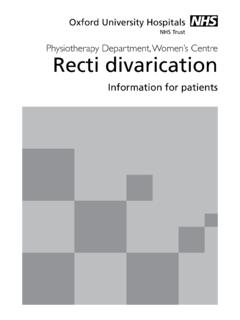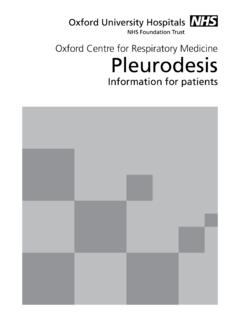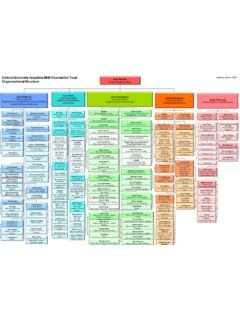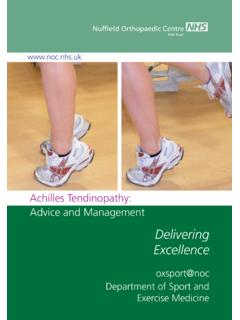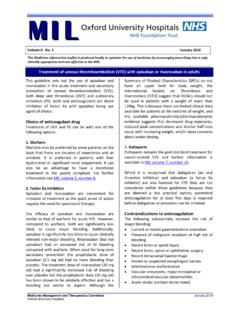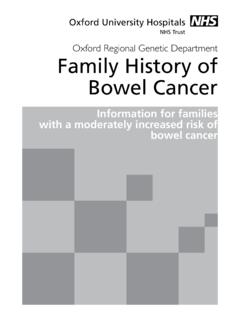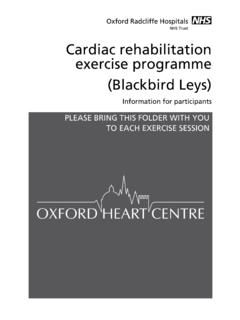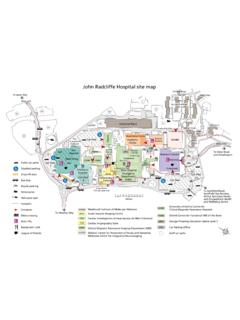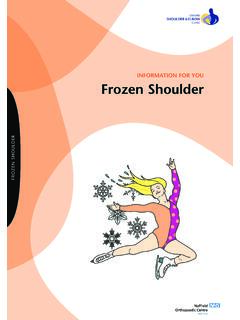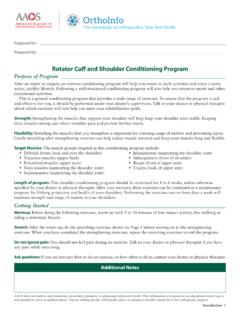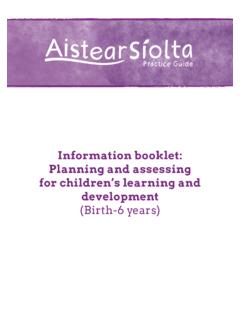Transcription of Oxford University Hospitals
1 Oxford University Hospitals NHS Trust Emergency Department Calf Strain Advice Information for patients page 2. What is a calf strain? A calf strain is a common injury and is often caused by overstretching or putting excess force through the calf muscles at the back of the lower leg. In this injury the muscle fibres are stretched and weakened, resulting in bleeding into the muscles. What are the symptoms? mild ache when resting to moderate pain when using the affected muscle swelling a change in the colour of your skin over your calf area, redness or bruising difficulty in rising up on your toes or pushing off from your foot. page 3. How is it treated? The first treatment is to calm the inflammation and control the swelling and pain. This can be managed with Rest, Ice, Painkillers and Elevation. R Rest: Rest will help prevent further injury and allows the healing process to begin.
2 For the first few days, reduce the amount of walking you do. Gently move your ankle regularly to avoid stiffness. Avoid forceful and strenuous activity such as running and jumping until you can walk without it causing any pain. Always try to walk normally, your heel strikes the floor first, rock forward on your foot and then push off with your toes. I Ice: Ice can help reduce swelling and reduce pain. Make an ice pack by wrapping a small bag of frozen peas or some crushed ice cubes in a damp towel. Put the ice pack on your injured ankle for 10 minutes every 2 hours for the first couple of days after the injury. Then use the ice pack 3 times a day until the swelling goes down. You can re- use the ice pack several times by re-freezing, but avoid eating food that has thawed and been refrozen. P Painkillers: It is important that you take regular painkillers to reduce the pain and help you keep mobile.
3 Paracetamol and ibuprofen are effective painkillers if taken regularly together. We do not routinely prescribe or dispense these as they can easily be purchased over the counter at chemists and many other shops. Please read the instructions on the packets carefully for the dosage. Please also check if there are reasons why you may not be able take these medications. E Elevation: Keep your injured ankle raised above the level of your hips for the first few days after the injury. This helps to reduce the swelling and pain. page 4. What about compression? We used to recommend using elasticated bandages for sprains and strains. Whilst they can help reduce swelling when it is severe, there is no consistent evidence that they make any difference to how quickly or well you may recover. This means that we no longer routinely dispense elasticated bandages. They are unlikely to do any harm, so if you do wish to try them they can be purchased from most pharmacies and other shops without a prescription.
4 Rehabilitation and recovery Healing of muscles normally takes about six weeks, though everyone recovers from injuries at different rates. How quickly your muscles heal will depend on how severe your injury is, as well as any other medical problems that you might already have. As healing gets underway, it is important you begin a series of exercises to gently stretch the calf muscle. This will help your knee and ankle joints to get back into their normal position. This helps to reduce the risk of further injury. page 5. Exercises 1. Sit with your leg out straight, keep your heel on the floor and gently stretch your foot up towards you as far as possible, with your toes pointing up and towards you. Hold for 5. seconds. Then point your foot away from you as far as possible. Hold for 5 seconds. Repeat 10 times. 2. Sit on a chair and straighten and bend your knee 10 times. 3. Facing a wall, put your hands against the wall at about eye level.
5 Keeping your injured leg back and the heel on the floor, take a small step forward with your uninjured leg and then lean in towards the wall (bending your uninjured leg at the knee) until you can feel a stretch in the back of your injured calf. Hold for 30 seconds. Repeat 4 times. Do this several times a day. 4. When you can stand on your toes without any pain, stand behind a chair for stability and balance yourself on both feet. Rise up onto your toes and hold for 5 seconds, then lower yourself back down. Repeat 4 times. Do this twice a day. Increase the number of repetitions every second day. Increase the time you hold the position by 5 seconds every week. page 6. Remember Seek medical attention immediately if: the pain and swelling increase despite resting your calf looks very red and is tender and hot to touch. If you have continuing problems with pain, swelling, problems using your calf or leg, or your injury is not recovering at the rate you expect, please see your GP.
6 It will be safe for you to return to normal activity when you have: full strength full range of movement (which means you can move your affected leg as much as the other one). can walk briskly without pain or swelling. Useful telephone numbers If you have any questions or concerns, please contact: Emergency Department John Radcliffe Hospital Tel: 01865 220 224. Emergency Department Horton Hospital Tel: 01295 229 412. Alternatively you can contact your GP or NHS 111 (Freephone), for emergency advice. page 7. If you have a specific requirement, need an interpreter, a document in Easy Read, another language, large print, Braille or audio version, please call 01865 221 473. or email Emergency Department John Radcliffe Hospital November 2014. Review date: November 2017. Oxford University Hospitals NHS Trust Oxford OX3 9DU. OMI 10921P.
